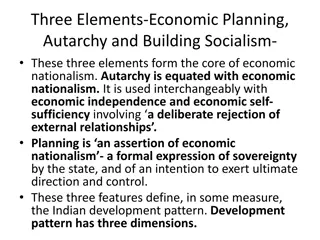The Struggle for Italian Unity: Nationalism and Obstacles
The journey towards Italian unity faced obstacles such as foreign rule, local princes, and Austrian dominance. Nationalists like Mazzini and Cavour played pivotal roles in unifying Italy, overcoming challenges through secret societies and shrewd political tactics. The movement for Italian unification in the 19th century was marked by revolutions, exiles, and the quest for a free and independent nation.
Download Presentation

Please find below an Image/Link to download the presentation.
The content on the website is provided AS IS for your information and personal use only. It may not be sold, licensed, or shared on other websites without obtaining consent from the author. Download presentation by click this link. If you encounter any issues during the download, it is possible that the publisher has removed the file from their server.
E N D
Presentation Transcript
Nationalism Unifying Italy
Obstacles to Italian Unity Though the people of the Italian peninsula spoke the same language, they had not experienced political unity since the Roman Empire By the early 1800s, Italian patriots were determined to build a new, united Italy Unification was brought about by a strong state and a shrewd politician Count Camillo Cavour
Obstacles to Italian Unity Italy had been a battleground for foreign and local princes Warfare and foreign rule led people to identify with local regions The invasions of Napoleon sparked dreams of national unity At the Congress of Vienna, Italian union was laughable and Austria took control of much of northern Italy while a French Bourbon ruler was put in charge of Naples and Sicily
Obstacles to Italian Unity Nationalists organized secret patriotic societies and focused their efforts on expelling Austria from northern Italy Between 1820 and 1848 nationalist revolts exploded across the region, but Austria troops were always sent in to crush the rebels
Mazzini Establishes Young Italy In the 1830s, nationalist leader Giuseppe Mazzini founded Young Italy The goal of the society was to unify Italy into one free, independent nation 1849: Mazzini helped set up a revolutionary government in Rome that was toppled by France Mazzini spent much of his life in exile dreaming of a unified Italy
The Struggle for Italy After 1848, leadership of the Italian nationalist movement passed to the Kingdom of Sardinia Sardinia s constitutional monarch, Victor Emmanuel II, hoped to join other states to his own increasing his power In 1852, VE made Count Camillo Cavour his prime minister
The Struggle for Italy Cavour came from a noble family but favored liberal goals He was a crafty politician willing to use almost any means to achieve his goals He was a monarchist who believed in the idea of Realpolitik
The Struggle for Italy Cavour moved first to reform Sardinia s economy Improved agriculture, built railroads, encourage commerce by supporting free trade His long-term goal was to end Austrian power in Italy
Intrigue With France 1855: Sardinia joined Britain and France in the Crimean War against Russia Though they did not win territory, they won a seat at the peace conference and gained the attention of Napoleon III 1858: Cavour negotiated a secret deal with Napoleon III, who promised to aid Sardinia in a war against Austria
Intrigue With France 1859: Cavour provoked a war with Austria With help from France, Sardinia defeated the Austrians and annexed Lombardy Nationalist groups overthrew Austrian-backed rulers in other northern Italian states who then joined with Sardinia
Garibaldis Red Shirts In the Kingdom of the Two Sicilies, Giuseppe Garibaldi, a longtime nationalist and ally of Mazzini was ready to act for Italian unification Though he wanted an Italian republic, he did not hesitate to accept help from the monarchist Cavour
Garibaldis Red Shirts By 1860, Garibaldi was able to recruit a force of 1,000 Red Shirt volunteers Cavour provided weapons and allowed 2 ships to sail Garibaldi and his men south to Sicily Garibaldi s forces quickly won control of Sicily and crossed the mainland marching north to Naples
Unity at Last Garibaldi s success alarmed Cavour, who believed Garibaldi would set up his own republic, and urged VE to send Sardinian troops to defeat Garibaldi The Sardinians overran the Papal States and joined up with Garibaldi in Naples
Unity at Last Garibaldi turned over Naples and Sicily to Victor Emmanuel and in 1861 he was crowned king of Italy Although Cavour died in 1861 with Rome and Venetia outside the new Italian nation, his successors completed his dream Italy won Venetia in the Austro-Prussian War and gained Rome when the French were forced to withdraw, uniting Italy for the first time since the Roman Empire
Italy Faces Challenges The united Italy faced challenges such as having no tradition of unity and strong regional rivalries that left Italy unable to solve national issues Greatest regional differences were between the north and the south North Italy was richer and had more cities that southern Italy
Italy Faces Challenges Northern Italy was a center for business and culture while southern Italy was rural and poor Though the south s population boomed, its inhabitants struggled to maintain a meager existence Hostilities between Italy and the Catholic Church arose due to papal resentment of the seizure of the Papal State The government did allow papacy limited rights and control over church property, but popes saw themselves as prisoners
Italy Faces Challenges Italy was a constitutional monarchy with a two house legislature Members of the upper house selected by the king and had veto power over laws passed in the lower house Lower house elected by the small number of men who held the right to vote
Italy Faces Challenges In the late 1800s, unrest increased as radical leftists struggled against a conservative government Socialists conducted strikes while anarchists turned to sabotage and violence Eventually, the government extended suffrage to more men and passed laws to improve social conditions While unrest continued, the government set out to distract by extending the empire to Ethiopia
Economic Progress Despite its problems, Italy developed economically Though the nation lacked natural resources, in the north many industries still sprang up Though the population was exploding, an important safety valve was emigration, and many Italians moved to the US

















































